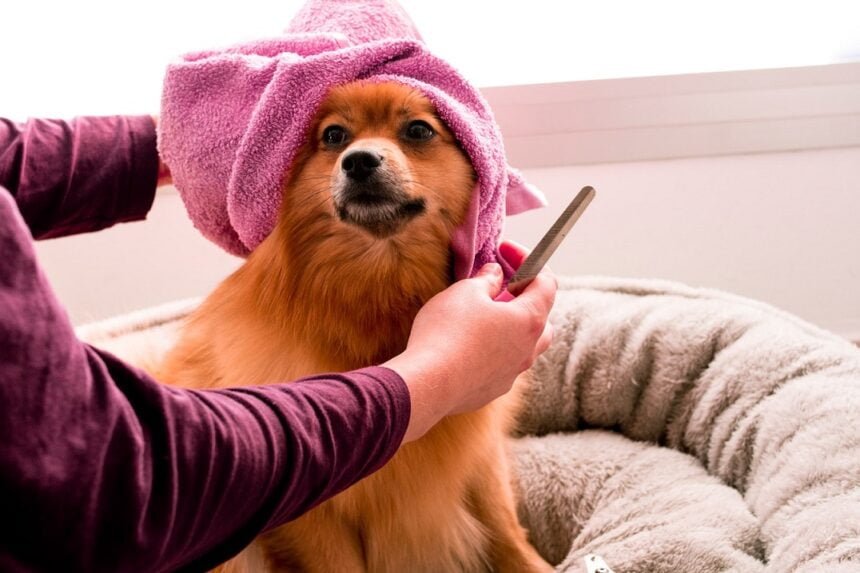Grooming and bathing are essential aspects of maintaining your dog’s overall health and well-being. Regular grooming not only keeps your dog’s coat clean and shiny but also helps prevent various skin conditions and infections. Bathing, on the other hand, helps remove dirt, odors, and parasites. In this comprehensive guide, we will walk you through the step-by-step process of grooming and bathing your dog, ensuring a happy and healthy pet.
Understanding Your Dog’s Coat:
Coat Types: Different breeds have different coat types, such as short, long, curly, or double coats. Understanding your dog’s specific coat type will help determine the appropriate grooming techniques.
Coat Lengths: Coats can vary in length, ranging from short to medium to long. Each length requires specific grooming methods to maintain its health and appearance.
Coat Care Requirements: Different coats have different care needs. Some may require daily brushing to prevent matting, while others may need regular trimming to avoid excessive shedding. Understanding your dog’s coat care requirements will help you develop an effective grooming routine.
Essential Grooming Tools:
Brushes and Combs: Various types of brushes and combs are available for different coat types. Choosing the right tools will help effectively remove tangles, mats, and loose fur from your dog’s coat.
Nail Clippers: Trimming your dog’s nails is an important grooming task to prevent overgrowth and discomfort. Nail clippers designed specifically for dogs should be used to avoid injury.
Ear Cleaning Solution: Dogs with floppy ears are prone to ear infections, so using a suitable ear cleaning solution helps maintain their ear hygiene.
Toothbrush and Toothpaste: Just like humans, dogs need regular dental care. Using a dog-specific toothbrush and toothpaste will help keep their teeth clean and prevent dental issues.
Shampoos and Conditioners: Choosing appropriate shampoos and conditioners formulated for dogs ensures a gentle and effective cleansing of their coat and skin.
Establishing a Grooming Routine:
Frequency of Grooming Sessions: The frequency of grooming sessions depends on your dog’s coat type and length, as well as their activity level. Regular grooming sessions prevent matting, tangling, and excessive shedding.
Creating a Calm Environment: Grooming can be stressful for some dogs, so creating a calm and comfortable environment will help them relax during grooming sessions.
Positive Reinforcement Techniques: Using positive reinforcement, such as treats and praise, will help your dog associate grooming with positive experiences, making it easier and more enjoyable for both of you.
Building Trust with Your Dog: Grooming requires handling sensitive areas of your dog’s body, so building trust and ensuring gentle handling is crucial for a successful grooming experience.
Brushing Your Dog’s Coat:
Removing Tangles and Mats: Brushing helps remove tangles, mats, and loose fur from your dog’s coat, preventing discomfort and skin issues.
Choosing the Right Brush or Comb: Different coat types require specific brushes or combs. Using the appropriate tool will make brushing more effective and comfortable for your dog.
Brushing Techniques for Different Coat Types: Each coat type requires specific brushing techniques, such as using long strokes or gentle circular motions. Understanding the right technique for your dog’s coat type will yield the best results.
Paying Attention to Sensitive Areas: Some areas, like the ears, tail, and underbelly, are more sensitive. Being gentle and using the right tools in these areas will prevent discomfort for your dog.
Trimming Your Dog’s Nails:
Importance of Regular Nail Trimming: Overgrown nails can be painful for dogs and may lead to issues with mobility. Regular trimming ensures their nails are kept at an appropriate length.
Tools for Nail Trimming: Using proper dog nail clippers or grinders is essential to avoid injury and pain.
Nail Trimming Technique: Trimming nails should be done carefully, avoiding the quick (the sensitive part containing blood vessels). Learning the correct technique will make the process safer and less stressful for both you and your dog.
Tips for Nervous Dogs: Some dogs may be anxious or fearful of nail trimming. Patience, positive reinforcement, and gradual desensitization can help ease their anxiety and make the process more comfortable.
Cleaning Your Dog’s Ears:
Why Ear Cleaning is Important: Regular ear cleaning helps prevent ear infections and removes dirt, wax, and debris that can accumulate in your dog’s ears.
Tools for Ear Cleaning: Specialized ear cleaning solutions and cotton balls or pads are commonly used to clean a dog’s ears.
Step-by-Step Ear Cleaning Process: Following a step-by-step process, including gentle application of the cleaning solution and careful wiping of the inner ear, ensures proper ear hygiene.
Signs of Ear Problems: Knowing the signs of ear problems, such as redness, odor, or excessive scratching, can help you detect any issues early and seek veterinary attention if necessary.
Brushing Your Dog’s Teeth:
Dental Health and Its Impact: Dental care is vital for your dog’s overall health. Regular teeth brushing helps prevent plaque buildup, gum disease, and other dental issues.
Selecting the Right Toothbrush and Toothpaste: Using a dog-specific toothbrush and toothpaste formulated for dogs is important to ensure effective and safe cleaning.
Introducing Teeth Brushing to Your Dog: Gradually introducing teeth brushing and using positive reinforcement will help your dog become comfortable with the process.
Brushing Techniques and Tips: Proper brushing techniques, including gentle circular motions and focusing on the gum line, will help maintain your dog’s oral health.
Bathing Your Dog:
Frequency of Baths: The frequency of baths depends on factors such as your dog’s breed, activity level, and coat condition. Over-bathing can strip the coat of natural oils, so it’s important to find the right balance.
Preparing for Bath Time: Gathering all necessary bathing supplies, such as towels, shampoo, and a non-slip mat, and preparing the bathing area ensures a smooth bathing experience.
Choosing the Right Shampoo and Conditioner: Selecting shampoos and conditioners suitable for your dog’s coat type and any specific skin conditions they may have is crucial for their skin health.
Bathing Technique and Safety Tips: Properly wetting the coat, lathering gently, rinsing thoroughly, and avoiding the eyes and ears are essential steps in bathing your dog safely.
Drying and Brushing After the Bath: Drying your dog’s coat thoroughly with towels or a pet dryer and brushing afterward helps prevent matting and keeps their coat looking its best.
Handling Special Grooming Situations:
Dealing with Shedding: Dogs that shed require additional grooming techniques, such as regular brushing with deshedding tools, to manage their shedding.
Grooming Puppies and Senior Dogs: Puppies and senior dogs have specific grooming needs and may require extra care and gentleness during grooming sessions.
Grooming Dogs with Skin Conditions: Dogs with skin conditions may require special shampoos or medicated treatments. Consulting with a veterinarian is recommended in such cases.
Professional Grooming Services: In some situations, seeking professional grooming services may be necessary or beneficial, especially for complex grooming tasks or specific breed cuts.
Beyond Grooming: Additional Care Tips:
Maintaining a Healthy Diet: Providing a balanced diet with high-quality ingredients promotes healthy skin and coat.
Regular Exercise and Mental Stimulation: Regular exercise and mental stimulation contribute to overall well-being, which reflects in your dog’s coat and overall appearance.
Preventing Fleas and Ticks: Implementing flea and tick prevention measures such as using preventative treatments, regular grooming to check for parasites, and keeping your dog’s environment clean can help prevent infestations.
Regular Vet Check-ups: Regular visits to the veterinarian ensure that your dog’s overall health is monitored, and any underlying issues can be addressed promptly.
By following the step-by-step instructions and tips provided in this guide, you can establish a grooming routine that keeps your dog’s coat clean, healthy, and free from tangles and mats. Additionally, proper bathing techniques and dental care contribute to their overall well-being. Remember to approach grooming with patience, positive reinforcement, and love, creating a positive experience for both you and your furry friend. By taking care of their grooming needs, you are contributing to their happiness and ensuring a healthy and well-maintained companion.







